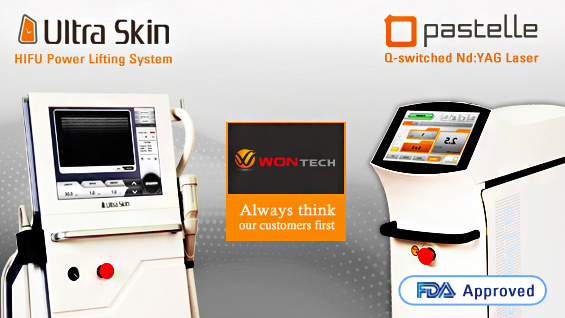▶ Previous Artlcle : #3-1. Treatment of Port-wine Stains
Long Pulse 755nm Alexandrite Laser
This laser has its wavelength between 595nm and 1064nm. 595nm has high absorption rate to hemoglobin and 1064nm shows deep penetration. Combining the two aspects, it shows both the deep penetration of the laser energy and selective targeting of hemoglobin. The Q-switched mode is used in pigmentary lesions.
As it can reach deeper lesions than PDL, it can be used in hyperplastic and nodular port-wine stains and lesions not responding well to PDL. High energy output can allow for deeper transmittance, however since the energy can be accumulated in melanin, it may lead to discoloration and tissue damage. Therefore, moderate parameters are advised for safer treatment.
[Advertisement] Ultra Skin/Pastelle – Manufacturer: WONTECH(www.wtlaser.com)]
Due to the advantages and disadvantages of single wavelength laser, lasers with multiple wavelengths are released for vascular treatment. For example, the 1064nm Nd:YAG is supplemented to 595nm PDL or 800nm Diode Laser is combined to 585nm PDL. When oxyhemoglobin is transformed into met-hemoglobin by PDL, it absorbs 1064nm Nd:AYG laser more easily, and therefore we can use PDL followed by Nd:YAG laser.
Photodynamic treatment
Although I personally haven't tried this method, rather than applying a laser alone, the recent photodynamic therapy is increasing in popularity which injects photosensitive substance (e.g. porphyrin metabolite) into target vessels before laser or phototherapy. When the photosensitive agent is exposed to the light beams, reactive oxygen species are generated to damage the surrounding tissues. The theory behind this method is supportable as strong light beams are only irradiated on target areas of the skin and dilated vessels hold more blood. IV injection of the photosensitive agent hematoporphyrin monomethyl ether followed by 578nm Copper Vapor Laser has been reported to bring 90% efficacy.
However, vascular endothelial cells that compose port-wine stains do not accumulate the photosensitive agent as well as neoplastic cells and the systemic administration of photosensitive agent may maintain photosensitivity in irrelevant areas of the body. Benzoporphyrin derivative monoacid A with shorter duration of photosensitivity of 5 days has been developed but 5 days could still cause a discomfort in clinical use. Future studies are needed to develop safer and more efficacious combination treatments.
Combination of laser and angiogenesis inhibitor
A key mechanism that lowers the efficacy of vascular laser treatment is the regeneration of damaged vessels (reperfusion). Therefore, inhibitory agent of angiogenesis can be combined with laser to enhance the efficacy of laser treatment. The most widely known medication is imiquimod, a drug well known to dermatologists in treating genital warts and hemangioma. A study using topical application of 5% imiquimod three times a week following PDL treatment reported significantly better outcome compared to PDL alone. Although closer examinations of dose and method of application should be conducted, this new treatment is still considerable.
Rapamycin, an immunosuppressant, can also inhibit angiogenesis and may increase the efficacy of laser treatment when used in combination. Although scientific evaluation have not been carried out, oral agents such as propranolol and timolol and topical beta-blockers used in infantile hemangioma may also inhibit angiogenesis after laser treatment.
Summary
Despite various lasers and new treatment methods, treatment of port-wine stains is still a challenge. Pooling the data of various studies, the cure rate could be estimated to be about 50%. The reasons for such low efficacy would be absorption of laser beams into epidermal melanin, quick dissipation of energy from small vessels to surroudings(lowered selectivity), limited depth of laser delivery, and high reperfusion rate of target vessels.
Based on current literature and my clinical experience, PDL is the primary treatment of choice in common pink or red port-wine stains. For deep purple or nodular lesions, 755nm Alexandrite, 800~900nm Diode, or 1064 Nd:YAG laser with longer wavelengths can be used alone or in combination. Photodynamic therapy or angiogenesis inhibition with imiquimod can be cautiously considered as additional treatment method in patients not responding to previous laser therapies.
References
❶ Chen JK, Ghasri P, Aguilar G, van Drooge AM, et al. An overview of clinical and experimental treatment modalities for port wine stains. J Am Acad Dermatol. 2012 Aug; 67 (2):289-304. ❷ Yuan KH, Li Q, Yu WL, Zeng D, Zhang C, Huang Z. Comparison of photodynamic therapy and pulsed dye Laser in patients with port wine stain birthmarks: a retrospective analysis. Photodiagnosis Photodyn Ther 2008;5:50-7. ❸ Faurschou A, Togsverd-Bo K, Zachariae C, Haedersdal M. Pulsed dye Laser vs intense pulsed light for port-wine stains: a randomized side-by-side trial with blinded response evaluation. Br J Dermatol 2009;160:359-64. ❹ Tremaine AM, Armstrong J, Huang Y-C, Elkeeb L, Ortiz A, Harris R, et al. Enhanced portwine stain lightening achieved with combined treatment of selective photothermolysis and imiquimod. J Am Acad Dermatol. 2012 Apr;66 (4):634-41 . ❺ Izikson L, Nelson JS, Anderson RR. Treatment of hypertrophic and resistant port wine stains with a 755 nm Laser: a case series of 20 patients. Lasers Surg Med 2009;41:427-32.
-To be continued-





















